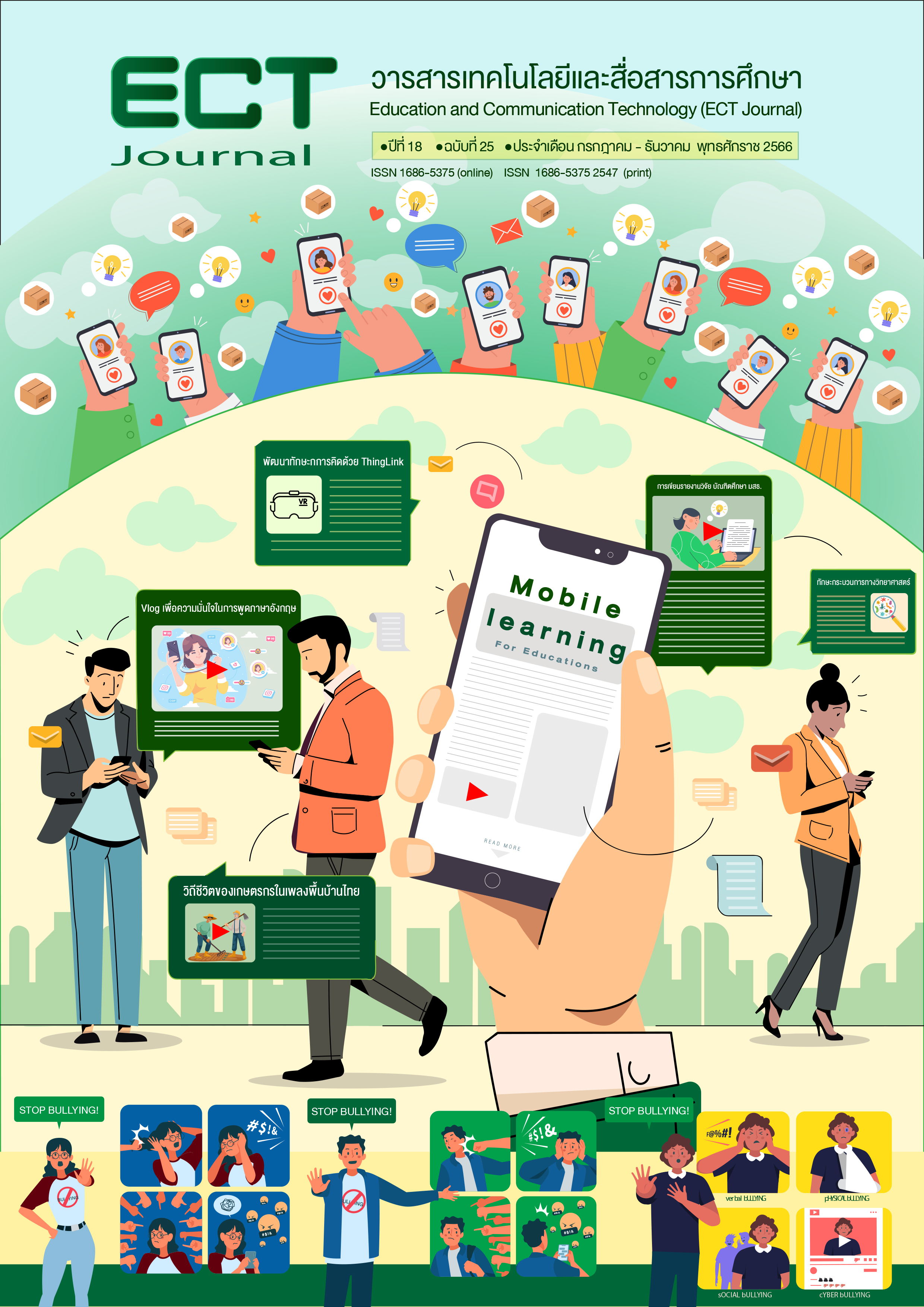An Exploratory Factor Analysis of Cyberbullying of Undergraduate Students
Keywords:
Cyberbullying, Exploratory factor analysis, Undergraduate studentsAbstract
The purposes of this study were to 1) study the factors of cyberbullying of undergraduate students and 2) analyze the exploratory factors of cyberbullying of undergraduate students. The sample was 466 graduate students (60.7% females with
a mean age of 19.75 years), who were selected with stratified random sampling based on their fields of study. The research instrument was a cyberbullying questionnaire. whose reliability was measured by internal consistency with Cronbach's alpha coefficients (.947). Data were analyzed by using the frequency, mean, eigenvalue, factor loadings and exploratory factor analysis (EFA), using common factor analysis with principal axis factoring and oblique rotation. The findings were as follows:
1. The factors of cyberbullying among undergraduate students can be divided into 3 aspects: 1) Cyberaggression 2) Cyberbystanding and 3) Cybervictimization
2.The first factor, 'Cyberaggression', consisted of 14 components, had the eigenvalue of 22.860, and revealed 51.955% of the variance, and the factor loadings between .669 and .922. The second factor is was 'Cyberbystanding', consisting of 15 components, with the eigenvalue of 6.371 and suggesting 14.479% of the variance and the factor loadings ranging from .542 to .889. The third factor is was 'Cybervictimization', consisting of 15 components, with the eigenvalue of 2.096 and revealing 4.763% of the variance. and the factor loadings ranging from .510 to .879.
References
กระทรวงการอุดมศึกษา วิทยาศาสตร์ วิจัยและนวัตกรรม. (2564). จำนวนนักศึกษาปัจจุบันปีการศึกษา 2563 จำแนกตามกลุ่มสถาบัน ชื่อสถาบัน คณะ สาขาวิชา ระดับการศึกษาและเพศ. สำนักงานสถิติแห่งชาติ. https://data.mhesi.go.th/dataset/2cf5431a-a1af-4cc5-915e-4755c3071fe7/resource/39b14d2f-970c-4e29-82bf-59179884b3d9/download/univ_std_11_01_2563.xlsx
กระทรวงการอุดมศึกษา วิทยาศาสตร์ วิจัยและนวัตกรรม. (2565). ข้อมูลสถิติจำนวนนักศึกษาปัจจุบัน ปีการศึกษา 2564 จำแนกตามกลุ่มสถาบัน ชื่อสถาบัน คณะ สาขาวิชา ระดับการศึกษาและเพศ. สำนักงานสถิติแห่งชาติ. https://data.mhesi.go.th/dataset/2cf5431a-a1af-4cc5-915e-4755c3071fe7/resource/9401fb7e-8df0-44a2-8d5d-0dd73b0f64ee/download/univ_std_11_01_2564.xlsx
กฤติศักดิ์ อนุโรจน์ และณัทธร พิทยรัตน์เสถียร. (2562). การศึกษาความเที่ยงและความตรงของแบบสอบถาม Cyber-Aggression Perpetration and Victimization Scale ฉบับภาษาไทย. วารสารสมาคมจิตแพทย์แห่งประเทศไทย, 64(1), 45-60.
กฤษฎา แสงเจริญทรัพย์ และวีนันท์กานต์ รุจิภักดิ์. (2564). Cyberbullying ความหมายและการทบทวนแนวคิดภายใต้บริบทไทย. วารสารกฎหมายและนโยบายสาธารณสุข, 7(1), 171-193. https://repository.li.mahidol.ac.th/handle/123456789/62127
ปรียานุช อภิบุณโยภาส. (2559). การวิเคราะห์องค์ประกอบเชิงสำรวจในการวิจัยองค์การ. วารสารการจัดการสมัยใหม่, 13(2), 23-36. https://so04.tci-thaijo.org/index.php/stou-sms-pr/article/view/59155
Cénat, J. M., Hébert, M., Blais, M., Lavoie, F., Guerrier, M., & Derivois, D. (2014). Cyberbullying, psychological distress and self-esteem among youth in Quebec schools. Journal of Affective Disorders, 169, 7-9. https://doi.org/10.1016/j.jad.2014.07.019
Emily, A. V. (2021, January 13). The state of online harassment. Pew Research Center. https://www.pewresearch.org/internet/2021/01/13/the-state-of-online-harassment
Garaigordobil, M. (2017). Psychometric properties of the Cyberbullying Test, a screening instrument to measure cybervictimization, cyberaggression, and cyberobservation. Journal of Interpersonal Violence, 32(23), 3556-3576. https://doi.org/10.1177/0886260515600165
Goretzko, D., Pham, T. T. H., & Bühner, M. (2019). Exploratory factor analysis: Current use, methodological developments and recommendations for good practice. Current Psychology, 40(7), 3510-3521. https://doi.org/10.1007/s12144-019-00300-2
Guerin, S., & Hennessy, E. (2002). Pupils' definitions of bullying. European Journal of Psychology of Education, 17(3), 249-261. https://www.jstor.org/stable/23420422
Kaiser, H. F., & Rice, J. (2016). Little Jiffy, Mark IV. Educational and Psychological Measurement, 34(1), 111-117. https://doi.org/10.1177/001316447403400115
Khong, J. Z. N., Tan, Y. R., Elliott, J. M., Fung, D. S. S., Sourander, A., & Ong, S. H. (2019). Traditional victims and cybervictims: Prevalence, overlap, and association with mental health among adolescents in Singapore. School Mental Health, 12(1), 145-155. https://doi.org/10.1007/s12310-019-09337-x
Merdan, E. (2022). The ugly face of the digital world: Cyberbullying. In I. Reisoğlu (Ed.), Handbook of research on digital violence and discrimination studies. IGI Global.
Pörhölä, M., Cvancara, K., Kaal, E., Kunttu, K., Tampere, K., & Torres, M. B. (2020). Bullying in university between peers and by personnel: Cultural variation in prevalence, forms, and gender differences in four countries. Social Psychology of Education, 23(1), 143-169. https://doi.org/10.1007/s11218-019-09523-4
Selkie, E. M., Kota, R., & Moreno, M. (2016). Cyberbullying behaviors among female college students: Witnessing, perpetration, and victimization. College Student Journal, 50(2), 278-287.
Simon, K. (2022, March 8). Digital 2022 global overview report. DataReportal. https://datareportal.com/reports/digital-2022-global-overview-report
Tomoyuki, U., Atsushi, N., Aoi, B., Itaru, K., Atsushi, B., Yuichiro, Y., & Hiroshi, I. (2021). Effect of introducing options for bystander behavior in catch ball tasks assuming bullying situations. Human Interface Society Journal, 23(2), 227-238.
Downloads
Published
How to Cite
Issue
Section
License
Copyright (c) 2023 มหาวิทยาลัยสุโขทัยธรรมาธิราช

This work is licensed under a Creative Commons Attribution-NonCommercial-NoDerivatives 4.0 International License.
1. ทรรศนะและข้อคิดเห็นใด ๆ ที่ปรากฏอยู่ในวารสาร ECT Education and Communication Technology Journal เป็นของผู้เขียนโดยเฉพาะ สำนักเทคโนโลยีการศึกษา มหาวิทยาลัยสุโขทัยธรรมาธิราช และกองบรรณาธิการไม่จำเป็นต้องเห็นพ้องด้วย
2. กองบรรณาธิการของสงวนลิขสิทธิ์ในการบรรณาธิการข้อเขียนทุกชิ้น เพื่อความเหมาะสมในการจัดพิมพ์เผยแพร่






